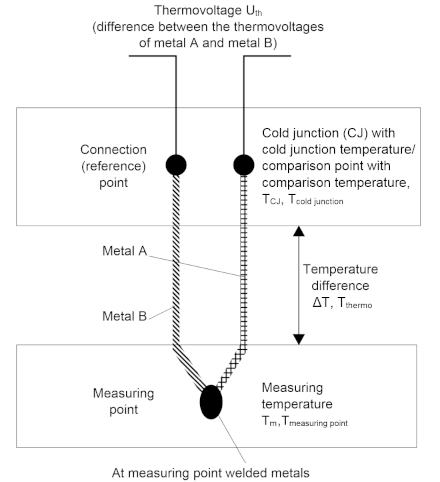TC technology basics
The thermocouple modules can evaluate thermocouples of the types B, C, E, J, K, L, N, R, S, T and U. The characteristic curves are linearized and the reference temperature determined directly within the module. Temperatures are output in 1/10°C, for example (device-dependent). The module is fully configurable via the bus coupler or the control system. Different output formats may be selected or own scaling activated. In addition, linearization of the characteristic curve and determination and calculation of the reference temperature (temperature at the terminal connection contacts) can be switched off.
Measuring principle of the thermocouple
Thermocouples can be classified as active transducers. They exploit the thermo-electric effect (Seebeck, Peltier, Thomson). A voltage referred to as thermovoltage occurs over the length of a cable with different temperatures at both ends. It is an unambiguous function of the temperature and the material. In a “TC element” this effect is utilized by operating two different conductor materials in parallel (s. fig.)

Example:
In the following example, the voltage Uth is given which is present at a type-K thermocouple at the temperature Tm.
Uth = (kNiCr - kNi) x ΔT
with
ΔT = Tm - Tv
A type-K thermocouple consists of a junction of a nickel-chrome alloy and nickel, where kNiCr and kNi represent the thermoelectric coefficients of nickel-chrome and nickel respectively. By adapting the equation according to Tm, the sought-after temperature can be calculated from the voltage measured across the thermocouple. Based on the difference to the cold junction temperature, the temperature at the measurement point can be determined to an accuracy of better than one tenth of a Kelvin with the aid of the above thermocouple equation.
 | Sensor circuit A modification of the sensor circuit with additional devices such as change over switches or multiplexer decreases the measure accuracy. We strongly advise against such modifications. |
Internal conversion of the thermovoltage and the reference voltage
Since the coefficients are determined at a reference temperature of 0°C, it is necessary to compensate for the effect of the reference temperature. This is done by converting the reference temperature into a reference voltage that depends on the type of thermocouple, and adding this to the measured thermovoltage. The temperature is found from the resulting voltage and the corresponding characteristic curve.
Uk = Um+ Ur
Tout = f(Uk)
Overview of suitable thermocouples
The following thermocouples are suitable for temperature measurement:
Type (according to EN60584-1) | Element | Implemented temperature range | Color coding (sheath - plus pole - minus pole) |
|---|---|---|---|
B | Pt30%Rh-Pt6Rh | 600°C to 1800°C | grey - grey - white |
C * | W5%Re-W25%Re | 0°C to 2320°C | n.d. |
E | NiCr-CuNi | -100°C to 1000°C | violet - violet - white |
J | Fe-CuNi | -100°C to 1200°C | black - black - white |
K | NiCr-Ni | -200°C to 1370°C | green - green - white |
L ** | Fe-CuNi | 0°C to 900°C | blue - red - blue |
N | NiCrSi-NiSi | -100°C to 1300°C | pink - pink - white |
R | Pt13%Rh-Pt | 0°C to 1767°C | orange - orange - white |
S | Pt10%Rh-Pt | 0°C to 1760°C | orange - orange - white |
T | Cu-CuNi | -200°C to 400°C | brown - brown - white |
U ** | Cu-CuNi | 0°C to 600°C | brown - red - brown |
* not standardized according to EN60584-1
** according to DIN 43710
 | Maximum cable length to the sensor Without additional protective measures, the maximum cable length from the EtherCAT Module to the sensor is 30 m. For longer cable lengths, suitable surge protection should be provided. |